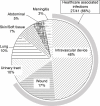Relationship between mortality and molecular epidemiology of methicillin-resistant Staphylococcus aureus bacteremia
- PMID: 35802589
- PMCID: PMC9269358
- DOI: 10.1371/journal.pone.0271115
Relationship between mortality and molecular epidemiology of methicillin-resistant Staphylococcus aureus bacteremia
Abstract
Staphylococcus aureus is the primary cause of bacteremia, and methicillin-resistant S. aureus bacteremia is associated with a high mortality rate. Methicillin-resistant S. aureus clones are widespread worldwide, and molecular epidemiological studies are important. Therefore, this study aimed to determine the characteristics of patients who died due to methicillin-resistant S. aureus bacteremia and microbiological characteristics of methicillin-resistant S. aureus strains in a tertiary teaching hospital. This single-center, retrospective study included patients with methicillin-resistant S. aureus isolated from blood bacterial culture performed at Kyoto Prefectural University of Medicine Hospital, from October 2016 to May 2019. The data analyzed included patient background, clinical strain characteristics, and molecular epidemiology. Of 41 patients with methicillin-resistant S. aureus bacteremia (median age, 60 [28-70] years; 24 (59%) were men), and 7 (17%) died due to methicillin-resistant S. aureus bacteremia. The median age of those who died in the methicillin-resistant S. aureus bacteremia group was predominantly higher than that of those in the alive group (p = 0.03). The most common cause of methicillin-resistant S. aureus bacteremia was endovascular devices, which occurred in 20 (49%), 18 (53%), and 2 (29%) patients in the total, alive, and died groups, respectively. Bacteriological characteristics showed that type IV Staphylococcal Cassette Chromosome mec genotype was most frequently detected in the total (n = 34 [83%]), alive (n = 29 [85%]), and died (n = 5 [71%]) groups. In the molecular cluster analysis, CC8, ST8, staphylococcal Cassette Chromosome mec type IV, and community-acquired-methicillin-resistant S. aureus formed the largest groups. The diversity of methicillin-resistant S. aureus clones is evident, and it is possible that clones with new virulence factors may still emerge. In the future, it will be crucial to monitor the epidemiological trends of methicillin-resistant S. aureus to respond quickly to changes in pathogenic and clonal factors, to clarify the gene expression network by identifying old and new virulence factors.
Conflict of interest statement
The authors have declared that no competing interests exist.
Figures



References
-
- Laupland KB, Lyytikäinen O, Søgaard M, Kennedy KJ, Knudsen JD, Ostergaard C, et al.. International Bacteremia Surveillance Collaborative. The changing epidemiology of Staphylococcus aureus bloodstream infection: a multinational population-based surveillance study. Clin Microbiol Infect. 2013;19(5): 465–471. doi: 10.1111/j.1469-0691.2012.03903.x - DOI - PubMed
-
- Pérez-Montarelo D, Viedma E, Larrosa N, Gómez-González C, Ruiz de Gopegui E, Muñoz-Gallego I, et al.. Molecular epidemiology of Staphylococcus aureus bacteremia: association of molecular factors with the source of infection. Front Microbiol. 2018;9: 2210. doi: 10.3389/fmicb.2018.02210 - DOI - PMC - PubMed
Publication types
MeSH terms
Substances
LinkOut - more resources
Full Text Sources
Medical

